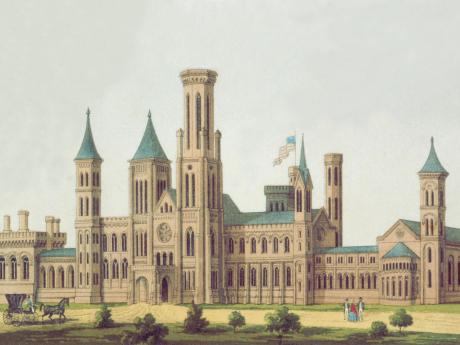Castle Collection
The Smithsonian Castle Collection was established in 1964 at the direction of the Institution’s eighth secretary, S. Dillon Ripley (1913-2001). Its purpose was to provide appropriate nineteenth century furnishings for the principal offices and rooms of the Smithsonian Institution Building, much like the White House and State Department, by producing “an interior that is in harmony with the exterior, and yet can serve usefully as offices and exhibit areas”.
The collection has grown to over 3500 accessioned objects and its scope has expanded to include the full stylistic range of historic furniture, decorative arts objects, and lighting devices intended primarily for daily use but also for study and exhibition. The collection also includes historic prints, drawings, and photographs of the Castle, objects relating to the Institution’s benefactor and namesake James Smithson, sculpture, and Castle-related objects.
Curation
The curator approves all new acquisitions, incoming and outgoing loans. The curator also conducts research on collection and related objects, prepares text for exhibitions and publications, and responds to inquiries from the public and staff regarding the collection and Castle history.
Collection Highlights and Exhibits
The registrar oversees the methods and procedures to maintain accountability of collection objects and their associated collection information as well as maintaining loan records. The registrar also conducts annual inventories and responds to inquiries from the public and staff regarding collection records.
In April 2022, the Smithsonian adopted a Shared Stewardship and Ethical Returns Policy. The policy acknowledges that ethical norms and professional best practices in collecting have changed. The Smithsonian has collections that it would not have acquired under present-day standards. Although the Smithsonian has legal title or custody of its collections, continued retention or sole stewardship may cause harm to descendants or communities and be fundamentally inconsistent with the Smithsonian’s ethical standards and values. In these circumstances, shared stewardship or ethical return may be appropriate.
The Smithsonian recognizes the value of community representation in its collections. Preserving and making available to the public—with honor and respect—a diverse range of collections, stories, and histories is essential to carrying out the Smithsonian’s role as collaborative custodian of cultural and historical legacies. Therefore, the Smithsonian is committed to working transparently and in consultation with individuals, descendent communities, and other stakeholders to consider matters of shared stewardship and the potential return of collections based on ethical considerations.
“This new policy is a cultural shift in our concepts of possession, ownership, and stewardship of collections. Its adoption is an expression of our values and commitment to meet our ethical obligations as a national and international cultural institution.” – Secretary Lonnie G. Bunch III
To submit a request with the Office of Architectural History and Historic Preservation’s Castle Collection, please contact the Collection at https://ahhp.si.edu/contact-us.
Process Following a Request Submission
Once a submission is received, the Office of Architectural History and Historic Preservation’s Shared Stewardship and Ethical Returns Committee will acknowledge the request, in writing, within 14 days of receipt of the request.
Each request or inquiry brought to the Committee will be reviewed comprehensively. The Committee will gather information, consult with the requesting or inquiring party, and conduct provenance research.
The Committee will consider the following criteria to evaluate requests for shared stewardship and ethical return:
- Is the requesting party the most appropriate party to make the inquiry or request? This determination will be made by considering the following:
- What is the nature of the requester’s relationship to the object(s)?
- Does the requester have authority to act on behalf of the party seeking shared stewardship or return (e.g., the family, community, cultural group, tribe, or government)?
- Are there competing inquiries or requests, or other parties with potential interests in the object(s)?
- Is the request an appropriate case for return or shared stewardship based on ethical considerations? This determination will be made by considering the following:
- How was the object(s) originally acquired?
- Is there evidence that the object(s) was acquired under duress, through coercion, without consent from the proper parties, or involuntarily?
- Would the Castle Collection’s continued possession of the disputed object perpetuate harm?
- Would shared stewardship or ethical return fundamentally redress harms?
When evaluating any request or inquiry, the Committee will not consider the requesting party’s ability to financially provide for the Smithsonian’s standards of care for the objects.
The Committee will then make their recommendations to senior Smithsonian leadership. Once a final determination is made, the Committee will notify interested parties regarding the decision.
To learn more about the Office of Architectural History and Historic Preservation’s Shared Stewardship and Ethical Returns policy please click here.
The conservator is responsible for the care and treatment of all collection objects and generates reports on all treatments. The conservator also keeps up to date on current conservation protocols and responds to inquiries from public and staff regarding conservation issues.
Explore the history of the Smithsonian Institution in The Castle: An Illustrated History of the Smithsonian Building (Revised Edition by Richard E. Stamm).
Available from various booksellers:









